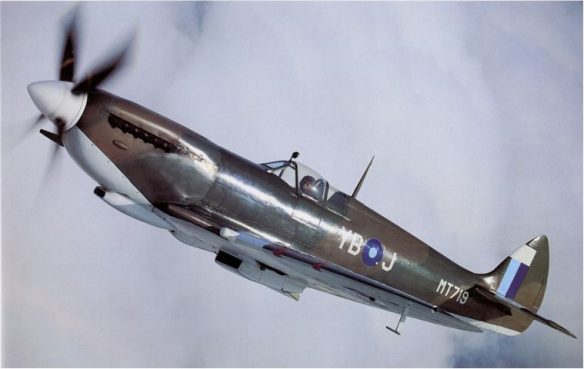The Supermarine Spitfire is one of the most famous fighter aircraft of the Second World War. It has the distinction of being the only fighter produced prior to 1939 that was manufactured right through the war, and into the years beyond. Ultimately, 20,351 Spitfires, in 40 major variants, were rolled out before production ceased in 1947. Throughout its history the Spitfire’s strengths were its speed and manoeuvrability, and that edge was maintained by constant technical refinement; the Spitfire Mk XXIV was a vastly different aircraft to the Spitfire Mk I. The Spitfire was principally a land-based air superiority fighter but was also employed in ground-attack and photo-reconnaissance roles, and, as the Seafire, was modified to operate from aircraft carriers. During the Second World War, it was flown in all theatres, by all the major Allied nations.
Australian pilots flew Spitfires with Royal Air Force squadrons in Europe, the Middle East and Burma, and four Royal Australian Air Force (RAAF) squadrons – 450, 452, 453 and 457 – operated them in the former two theatres. 452 and 457 Squadrons also flew the Spitfire in the South-West Pacific Area, as did 79 and 85. The first Spitfires arrived in Australia in August 1942. The Spitfire presented some difficulties in the South-West Pacific, owing to its relatively short range, mechanical problems resulting from climatic conditions, and its fragile undercarriage, which was not well-suited to the rough airstrips found throughout the theatre. Australian-produced variants of the P-51 Mustang were designated to succeed the Spitfire in RAAF service, and it was effectively retired at the end of the Second World War. A total of 656 Spitfires served with the RAAF.
The MkVIII Spitfire
The Mark VIII was essentially a modified Mk VII fitted with either a 1565 HP Merlin 61 or a 1710 HP Merlin 63 engine driving a 4-bladed propeller. The aircraft was particularly suited to lower altitudes, particularly as the cockpit was unpressurised.
Supermarine in conjunction with Rolls Royce redesigned the carburetor to enable the aircraft to perform negative “g” maneuvering. The Mk VIII was intended as the next major developmental line for the Spitfire, but with the Mk IX hurried into service, only 1652 were eventually produced, many modified for tropical climates such as those experienced by RAAF aircraft in the Pacific Theatre.
Specifications:
Supermarine Spitfire Mk VIII
Type: Fighter
Entered service: 1942
Crew: 1
Wing span: 11.32 m
Length: 9.5 m
Weight (unladen): 2,633 kg
Ceiling: 12,650 m
Endurance: Maximum range 1,062 km
Speed: 650 km/h
Armament: 4 x .303-in machine-guns
2 x 20-mm cannons up to 227 kg of bombs
